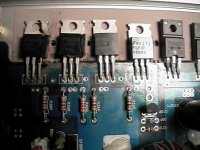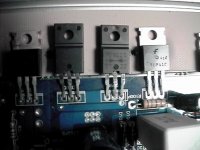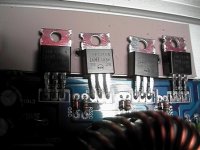Actually, most amps are very similar when it comes to basic troubleshooting. Odds are, you missed another shorted part, or an open resistor, both of which could cause the problem you described. My suggestion is this: go up a level to this forum, and click on the post about the Xtant. If you go to the last page, you'll see a rather lengthy post about how to test for the most common problems, and how to repair them. The parts in your amp are probably different, but the way you measure them is exactly the same - none of the transistors should read shorts on any pins, and the resistors should be within 1 ohm of their value. If you don't know the value of your resistors, you can look up the color code online, or you can post the colors here and I'll tell you what it is. Since I neglected to mention it in the other thread, avoid the rectifiers when you're measuring/replacing the transistors - they often look just like them, and will read like they're shorted, but aren't. You can recognize them by the part number prefix of U, MUR, or FEP, the suffix of R, two pins, or a diagram of a diode on the part. They only short once in a blue moon, so you don't need to worry about them. If you have any questions about the parts, or want to buy some of each, let me know. We'll give you a good deal and get them there fast.
- Sara
- Sara
I got a multimeter and tested the resistors dirictly in front oh the fets that were blown and 4 that should have been at 100ohms only tested at 25ohms...you can see them in the first picture. I also tried to tested the other fets and the first one and the last two in the last picture didnt have measure any ohms. Can you please advise me on what my next step should be?
Attachments
Ahhh, PS repair
Basic Things you need to fix this:
Current Limited 10A 12Volt power supply with Ammeter
DMM with Diode Check
Let's start with the amp's power supply. You should first remove the offending transistors. Next, measure the remaining MosFet for a short circuit across pins 2 and 3 (Drain and Source). If it's reading .000, you have a shorted MosFet. If it's 0.534 or similar, you are reading the voltage drop of the MosFet's body diode and everything is cool. Repeat this check with all remaining MosFets in the power supply. The devices with little pics of diodes on them are just that...diodes. Sometimes they go bad, but much less often. Feel free to check them. One will have a common anode (plus) and the other will have a common cathode (minus) on pin 2. Both will read about 0.350 from pin 1-2 and pin 3-2 when they are in proper condition.
Connect the amp to your new (or borrowed) power supply. Yes, without the three removed transistors. If they were the only offending parts, the amp will turn on just fine - even operating with ONE MosFet on that side. It won't work WELL, but it will turn on.
Connect the amp to the PS without the remote lead connected. If the amp suddenly draws a ton of current upon connecting BAT+ and GND, you have a shorted FET across Drain and Source.
If the amp draw a ton of current as soon as you connect the remote lead, you have:
1) Shorted buffer/speed up driver transistor. Typically a single NPN or NPN/PNP pair in totem pole configuration driving the Gates of the bank of Mosfets through Gate resistors (the resistors right near the MosFets in question).
a) Pull the remaining Mosfet out of that bank and replace all four with new ones. The current limiting of the 12V power supply will prevent you from blowing the new ones.
b) Using your diode check on the DMM, check for C-E shorts on the afore-mentioned driver transistors. If you read anything less than about .500 on the ol'd DMM display, replace the transistors.
2) Shorted output (audio) section. Since this is a switching amplifier, I cannot comment on the particular arrangement of your amplifier. You will be best served to find someone that can get a hands on look at the section. In short, it requires a lot more test equipment than you probably have.
3) Damaged PWM Controller. Really, the only easy way to see if it's oscillating is to put a o'scope probe on it.
If the amp draws a lot of current over a few seconds time:
0.5) A slow short. Just kidding.
1) Output section has a problem.
a) Output isn't oscillation at correct frequency
b) Deadtime adjustment is incorrect
c) Body diodes on ouput transistors are leaky
See #3 above.
Sorry I can't be of more help in that arena, but I've never seen anyone be able to t'shoot that type of amp over a forum. I won't be the first to attempt that, either.
Basic Things you need to fix this:
Current Limited 10A 12Volt power supply with Ammeter
DMM with Diode Check
Let's start with the amp's power supply. You should first remove the offending transistors. Next, measure the remaining MosFet for a short circuit across pins 2 and 3 (Drain and Source). If it's reading .000, you have a shorted MosFet. If it's 0.534 or similar, you are reading the voltage drop of the MosFet's body diode and everything is cool. Repeat this check with all remaining MosFets in the power supply. The devices with little pics of diodes on them are just that...diodes. Sometimes they go bad, but much less often. Feel free to check them. One will have a common anode (plus) and the other will have a common cathode (minus) on pin 2. Both will read about 0.350 from pin 1-2 and pin 3-2 when they are in proper condition.
Connect the amp to your new (or borrowed) power supply. Yes, without the three removed transistors. If they were the only offending parts, the amp will turn on just fine - even operating with ONE MosFet on that side. It won't work WELL, but it will turn on.
Connect the amp to the PS without the remote lead connected. If the amp suddenly draws a ton of current upon connecting BAT+ and GND, you have a shorted FET across Drain and Source.
If the amp draw a ton of current as soon as you connect the remote lead, you have:
1) Shorted buffer/speed up driver transistor. Typically a single NPN or NPN/PNP pair in totem pole configuration driving the Gates of the bank of Mosfets through Gate resistors (the resistors right near the MosFets in question).
a) Pull the remaining Mosfet out of that bank and replace all four with new ones. The current limiting of the 12V power supply will prevent you from blowing the new ones.
b) Using your diode check on the DMM, check for C-E shorts on the afore-mentioned driver transistors. If you read anything less than about .500 on the ol'd DMM display, replace the transistors.
2) Shorted output (audio) section. Since this is a switching amplifier, I cannot comment on the particular arrangement of your amplifier. You will be best served to find someone that can get a hands on look at the section. In short, it requires a lot more test equipment than you probably have.
3) Damaged PWM Controller. Really, the only easy way to see if it's oscillating is to put a o'scope probe on it.
If the amp draws a lot of current over a few seconds time:
0.5) A slow short. Just kidding.

1) Output section has a problem.
a) Output isn't oscillation at correct frequency
b) Deadtime adjustment is incorrect
c) Body diodes on ouput transistors are leaky
See #3 above.
Sorry I can't be of more help in that arena, but I've never seen anyone be able to t'shoot that type of amp over a forum. I won't be the first to attempt that, either.
- Status
- This old topic is closed. If you want to reopen this topic, contact a moderator using the "Report Post" button.


